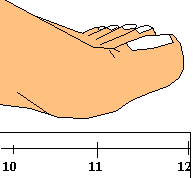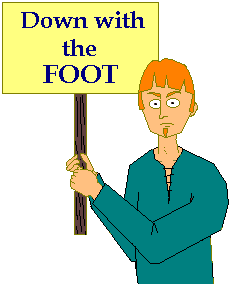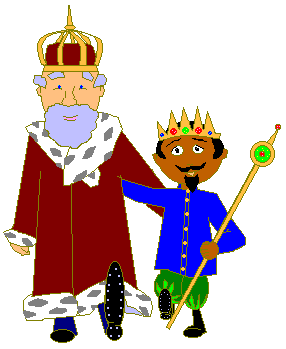Disclaimer - I don't know how much, if any, of this story is true. It may be completely false, it may be frighteningly accurate. I also claim no authorship of this story. Somehow, the story got into my head (I watched too much PBS growing up) and I'm sure I've modified, altered and frankly warped it over the years. At any rate, it's a good story, and I'll continue to tell it. By the way, if you know where this story came from, please let me know.
The English System of Measurement
(Or the Tale of The King's Foot)
In the earliest days, people had no system for measurement. They didn't need one. If you wanted to build a doorway, you built it tall enough to walk through. If you wanted to get some water, you just found a big pot and got some. The land you farmed might stretch to the stream, or to the forest, or as far as you could walk in a single day. There was no need to measure anything with accuracy.
But this didn't last long. People started to work together, and they needed to compare the things they did. "How long is your barn?" a neighbor might ask. Unless you had a way to measure, you couldn't really answer. The single farms gave way to villages, and people were communicating more and more.
 The earliest measurements were taken with parts of the body. A cubit was the distance between the elbow and the fingertips. A span was the width of a hand. If you needed shorter measurements, you could use the distance between the joint and the tip of the thumb. This came to be known as the inch. A yard was about the distance between footsteps. A foot was -- you guessed it -- the length of a foot.
The earliest measurements were taken with parts of the body. A cubit was the distance between the elbow and the fingertips. A span was the width of a hand. If you needed shorter measurements, you could use the distance between the joint and the tip of the thumb. This came to be known as the inch. A yard was about the distance between footsteps. A foot was -- you guessed it -- the length of a foot.
This worked well, for a while. Some people were better at farming than others. Some people developed special skills working with word or metal or painting. As people got different jobs, the standards of measurement changed.
About this time, kings ruled the land, and whatever the king wanted, he got. If the king wanted your land, he'd take it. If he wanted your horse, he could. If he wanted your pet chicken for dinner, say goodbye to ol' clucky.
During these days, the king of England wanted a bed. He told the carpenter he wanted the bed eight feet long and six feet wide. The carpenter made the bed exactly as the king asked, but when the carpenter had finished, the king wasn't satisfied.
"That bed is too short," he exclaimed. "You didn't follow my directions."
"But I followed them exactly, your majesty. That bed is eight feet long and six feet wide."
The king glanced down, and noticed that the carpenter's feet were unusually small. The king, on the other hand, had long feet. The king, wise as he was, quickly spotted the problem.
 "Your feet are too small," he claimed. He, being the king, didn't want to say that his feet were large. "You must use my feet as your measurement."
"Your feet are too small," he claimed. He, being the king, didn't want to say that his feet were large. "You must use my feet as your measurement."
So the carpenter found a stick and measured the length of the king's foot. All of the other carpenters in the land had to use this same measurement as well. Because this stick was measured on the king, it became known as a ruler, and such sticks are called rulers to this day.
 Again, all this worked very well, for a while. But what happens when two countries meet? The French king doesn't want his bed measured with the English king's feet! And what about the countries at war with England? There was no way they'd use the English king's foot. Problems were arising.
Again, all this worked very well, for a while. But what happens when two countries meet? The French king doesn't want his bed measured with the English king's feet! And what about the countries at war with England? There was no way they'd use the English king's foot. Problems were arising.
In fairly recent times, scientists decided to make a system for measuring which didn't involve anyone's feet. They calculated the distance between the north pole and the equator. They then divided that distance into a thousand parts, and then divided each part into a thousand parts again. They came up with a length just over a yard and they named it the METER. Meter is the Latin word for measure, and scientists are pretty fond of Latin. It was a handy stick, and it could be used by all countries, regardless of their leadership.
Similarly, scientists came up with liquid measurements. They took one thousand cubic centimeters of water and called it a liter. They then took one of those cubic centimeters of water and weighed it (or, more accurately, calculated its mass). They then had the unit known as the gram.
Those crazy scientists didn't stop there, but they took some of that water and boiled it at sea level. It always boiled at the same temperature. The called this point one hundred degrees. Water also froze at the same temperature, and they called that zero degrees. This is known as the Centigrade, or Celcius scale.
Most of the world now uses the metric system, and all scientists use this system when reporting on their findings. Only slowly has the metric system been introduced in the United States. Thankfully, those two liter bottles are familiar to us all. It's hard for the U.S. to adapt to a different sistem. It seems like we still prefer to use the old king's foot for our standard.


 The earliest measurements were taken with parts of the body. A cubit was the distance between the elbow and the fingertips. A span was the width of a hand. If you needed shorter measurements, you could use the distance between the joint and the tip of the thumb. This came to be known as the inch. A yard was about the distance between footsteps. A foot was -- you guessed it -- the length of a foot.
The earliest measurements were taken with parts of the body. A cubit was the distance between the elbow and the fingertips. A span was the width of a hand. If you needed shorter measurements, you could use the distance between the joint and the tip of the thumb. This came to be known as the inch. A yard was about the distance between footsteps. A foot was -- you guessed it -- the length of a foot. "Your feet are too small," he claimed. He, being the king, didn't want to say that his feet were large. "You must use my feet as your measurement."
"Your feet are too small," he claimed. He, being the king, didn't want to say that his feet were large. "You must use my feet as your measurement."
 Again, all this worked very well, for a while. But what happens when two countries meet? The French king doesn't want his bed measured with the English king's feet! And what about the countries at war with England? There was no way they'd use the English king's foot. Problems were arising.
Again, all this worked very well, for a while. But what happens when two countries meet? The French king doesn't want his bed measured with the English king's feet! And what about the countries at war with England? There was no way they'd use the English king's foot. Problems were arising.
